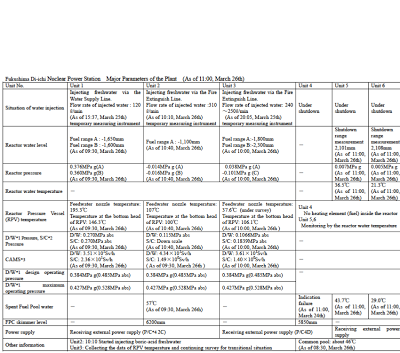UPDATE AS OF 9:30 A.M. EDT, MARCH 26
Japanese scientists yesterday detected higher levels radioactive iodine in seawater at water outlets near the Fukushima Daiichi nuclear power plant.
“Iodine 131 was detected at a level 1,250 times the national safety limit,” Hidehiko Nishiyama of the Nuclear and Industrial Safety Agency said during a news conference. Officials said there is no immediate danger to residents near the plant from these levels.
Japan’s Nuclear and Industrial Safety Agency english website is here
UPDATE AS OF 7:00 P.M. EDT, MARCH 25:
Samples taken on Friday were significantly higher than those taken on Wednesday, which had 147 times the legal concentration of I-137. Authorities said the concentration of radioactive materials in the water will decrease as the water is diluted by ocean currents. Indeed, a sample taken at 8:50 a.m. on Friday had one-fifth the concentration of I-131 as the earlier measurement. Three subsequent measurements that morning showed fluctuation. All were below the highest level found at 8:30 a.m. on Friday.
“As of now, there is no report of adverse impact on the marine life, especially beyond kilometers [of the plant],” said Chief Cabinet Secretary Yukio Edano. “Experts say there is a very low possibility, but we must strengthen our monitoring.”
Efforts to cool the reactors and fuel pools continues at the Daiichi site. Fresh water is now being used to cool reactors 1, 2 and 3 in lieu of seawater. Workers began injecting fresh water at reactors 1 and 3 on March 25 and at reactor 2 on March 26. Meanwhile, two U.S. Navy barges carrying 500,000 gallons fresh water are en route to a port 37 miles south of the Fukushima plant.
Fresh water is being injected into the reactor pressure vessel at reactor 3 at Fukushima Daiichi nuclear power plant, Japan’s Nuclear and Industrial Safety Agency said.
TEPCO said that radioactive materials discovered at the reactor 3 turbine building possibly came from water from the reactor system, not the spent fuel pool. TEPCO made that statement after collecting samples of contaminated water in the reactor 3 turbine building and conducting a gamma-emitting nuclide analysis of the sample. The reactor pressure and drywell pressure at reactor 3 remained stable on Friday, leading TEPCO to believe that “the reactor pressure vessel is not seriously damaged.
Cooling efforts at Reactor 1 already had switched back to fresh water cooling. Reactor 2 is still being injected with seawater, but is expected to switch to fresh water soon.
Tokyo Electric Power Co. said that crews continued spraying water into the used fuel storage pools at reactors 3 and 4 on Friday to keep the used uranium fuel rods safe. Also on Friday, the heat removal system at reactor 6 was switched to a permanent power supply, NISA added.
TEPCO said it was assessing the radiation dose to two workers who were contaminated while laying cable in the turbine building of reactor 3. TEPCO said it had instructed its employees and contract workers to pay attention to their personal radiation dosimeter alarms and evacuate when necessary.
Radiation Monitoring Update
Air and seawater sampling continues by the Japanese government. Measurements in the ocean were taken 30 kilometers off-shore and 330 meters from the discharge points on March 23 and March 24. Results indicate concentrations of iodine-131 at 2,162 picocuries per liter and cesium-137 at approximately 703 picocuries per liter. Adult consumption of 1,000 picocuries (1 picocurie is one-trillionth of a curie) per liter concentration for 30 days will result in 24 millirem of radiation dose. For comparison, a typical dose from a chest x-ray is 10 millirem.
The concentrations found in the seawater samples are most likely “due to atmospheric fallout rather than just ocean currents,” IAEA said. Dilution is expected to rapidly decrease this surface contamination, IAEA added.
Iodine-131 was detected in drinking water in 13 prefectures and cesium-137 was detected in drinking water in six prefectures. All results remained below the limits set by the Japanese government, IAEA said. Iodine-131 levels in drinking water in Tokyo are now below limits for consumption by infants set by the Japanese authorities and restrictions have been lifted.
On March 25, the IAEA radiation monitoring team made additional measurements at distances from 34 to 62 kilometers from the Fukushima Daiichi nuclear power plant. At these locations, the radiation dose rate was at extraordinarily low levels, ranging from 0.073 millirem per hour to 0.88 millirem per hour.
If you liked this article, please give it a quick review on ycombinator or StumbleUpon. Thanks

Brian Wang is a Futurist Thought Leader and a popular Science blogger with 1 million readers per month. His blog Nextbigfuture.com is ranked #1 Science News Blog. It covers many disruptive technology and trends including Space, Robotics, Artificial Intelligence, Medicine, Anti-aging Biotechnology, and Nanotechnology.
Known for identifying cutting edge technologies, he is currently a Co-Founder of a startup and fundraiser for high potential early-stage companies. He is the Head of Research for Allocations for deep technology investments and an Angel Investor at Space Angels.
A frequent speaker at corporations, he has been a TEDx speaker, a Singularity University speaker and guest at numerous interviews for radio and podcasts. He is open to public speaking and advising engagements.


